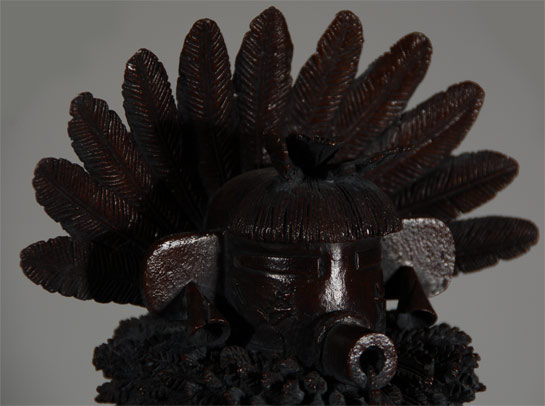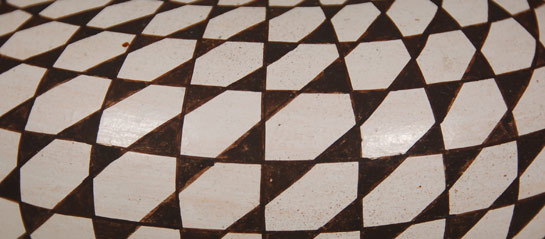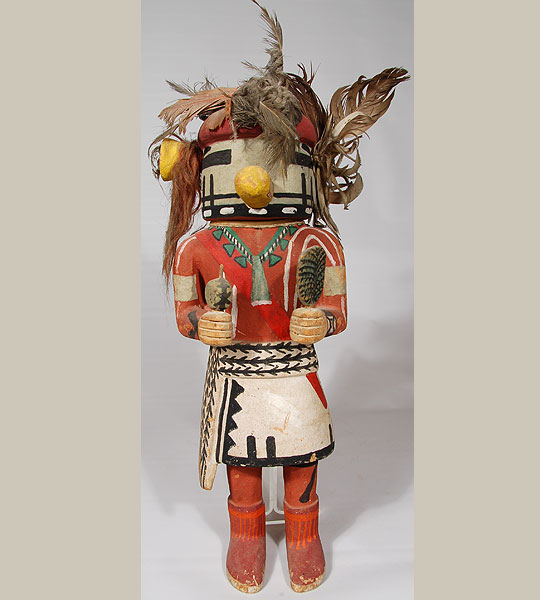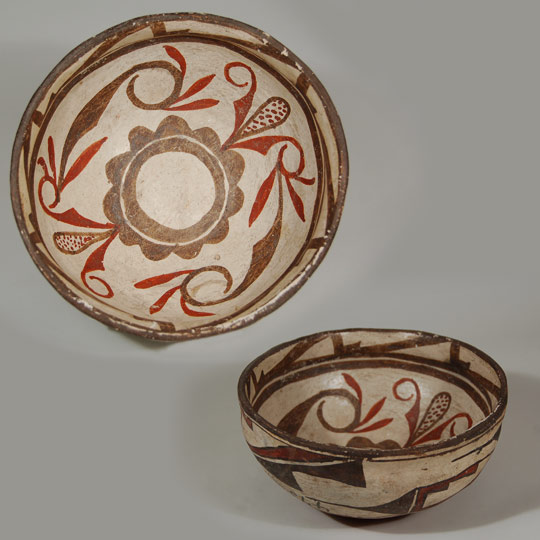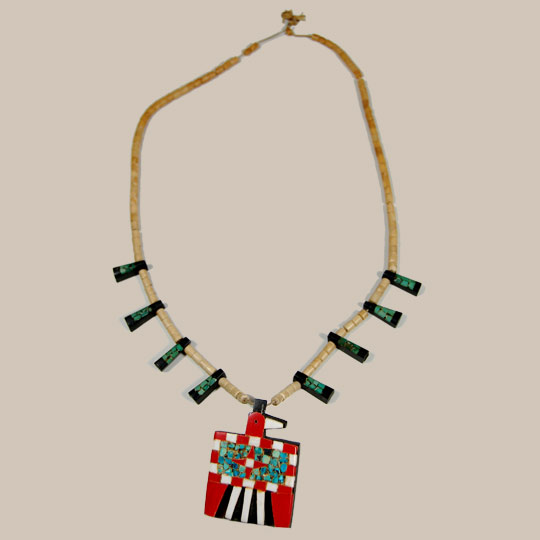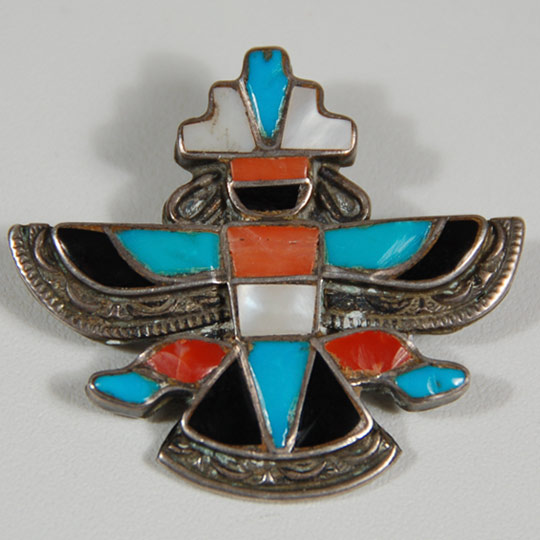Subject: Hopi Monochromatic Low Bowl
Garnet Pavatea was known as Flower Girl and she was a Hopi-Tewa from the Tewa Village on First Mesa on the Hopi Reservation. Her dad, Dewakuku, was Hopi and her mother was Tewa. Following tradition, Garnet was of her mother's clan.
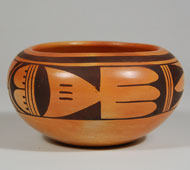 Hopi artisans owe much thanks to Mary-Russell Ferrell Colton, co-founder of the Museum of Northern Arizona in Flagstaff. She was instrumental in creating the Hopi Craftsman Exhibition in the early 1930s with the intent of fostering production of quality work. She was concerned that traders were content to accept and sell mediocre work from Hopi craftsmen and were not interested in educating the public on quality crafts. She organized the craft exhibit for the July 4th weekend every year and it has served her intent to greatly increase interest in quality Hopi crafts.
Hopi artisans owe much thanks to Mary-Russell Ferrell Colton, co-founder of the Museum of Northern Arizona in Flagstaff. She was instrumental in creating the Hopi Craftsman Exhibition in the early 1930s with the intent of fostering production of quality work. She was concerned that traders were content to accept and sell mediocre work from Hopi craftsmen and were not interested in educating the public on quality crafts. She organized the craft exhibit for the July 4th weekend every year and it has served her intent to greatly increase interest in quality Hopi crafts.
Garnet Pavatea was a long-time entrant in the craft exhibit and won many awards by doing so. She also seemed to be a favorite of the Museum of Northern Arizona. She was often a demonstrator at the Craftsman Exhibition. For a number of years, Adobe Gallery had a standing order from the Museum of Northern Arizona for any Garnet Pavatea pottery available.
This small bowl is a fine example to illustrate the careful craftsmanship of Pavatea. The bowl was beautifully formed, polished inside and outside and painted with the utmost care. It is an excellent example of this potter's work.
Condition: excellent condition
Provenance: from an Albuquerque family
Recommenced Reading: Contemporary Hopi Pottery by Laura Graves Allen
Subject: Hopi Monochromatic Low Bowl
Artist / Potter: Garnet Pavatea (1915-1981) Flower Girl
Category: Contemporary
Origin: Hopi Pueblo
Medium: clay, pigment
Size: 2-7/8" deep x 5-1/8" diameter
Item # 25579
Subject: Santa Clara Small Red Sgraffito Seed Jar
Golden Rod is a daughter of Petra Gutierrez and sister of Minnie Vigil, Lois Gutierrez and Thelma Talachy. The ancestral family home is Pojoaque Pueblo, but most now live at Santa Clara Pueblo. All of the siblings are outstanding potters and all are active today.
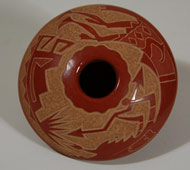 This small mushroom-shaped seed jar is stone-polished over its entire surface, then decorated with a petroglyph-style design in sgraffito carving. There are two petroglyph-style human-type figures, one of which is carrying a spear and wearing a buffalo-type head cover. The other is hard to interpret.
This small mushroom-shaped seed jar is stone-polished over its entire surface, then decorated with a petroglyph-style design in sgraffito carving. There are two petroglyph-style human-type figures, one of which is carrying a spear and wearing a buffalo-type head cover. The other is hard to interpret.
Condition: original excellent condition
Provenance: from a family in Santa Fe
Subject: Santa Clara Small Red Sgraffito Seed Jar
Artist / Potter: Gloria Garcia (b.1942) Golden Rod
Category: Contemporary
Origin: Santa Clara Pueblo
Medium: clay
Size: 1-1/8" deep x 2-1/2" diameter
Item # C3367C
Subject: Santa Clara Matte Black Lidded Jar
Dolores Curran, originally from Santa Clara Pueblo, married and moved to Ohkay Owingeh Pueblo around 1977. She has specialized in miniature pottery since her first piece at age 9. Her designs are each original to the piece of pottery on which she is working. She does not record her designs because she doesn't want to start copying herself. She prefers to fit each design to the pot on which it goes.
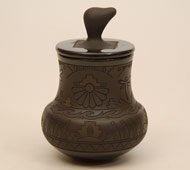 This exquisite small jar is a miniature version of a storage jar. The exception to that would be the lid as a standard storage jar would generally not have a lid. In her incomparable fashion, she reversed the normal pattern of burnishing the entire jar and then painting a design in matte paint. Here she has left the entire jar in matte finish except for the burnished rim and base and the top of the lid. Her designs were carved with the utmost care and precision. Dolores stated that she applies as many as five coats of slip to each design. In her scale of work, she is unmatched by any others.
This exquisite small jar is a miniature version of a storage jar. The exception to that would be the lid as a standard storage jar would generally not have a lid. In her incomparable fashion, she reversed the normal pattern of burnishing the entire jar and then painting a design in matte paint. Here she has left the entire jar in matte finish except for the burnished rim and base and the top of the lid. Her designs were carved with the utmost care and precision. Dolores stated that she applies as many as five coats of slip to each design. In her scale of work, she is unmatched by any others.
Dolores Curran and Geri Naranjo are sisters and both work in miniature scale. Dolores's daughter, Ursula Curran, also makes miniature pottery. The entire family is very talented.
Condition: new
Provenance: from the potter through an intermediary
Recommended Reading: Pueblo Indian Pottery: 750 Artist Biographies by Gregory Schaaf
Subject: Santa Clara Matte Black Lidded Jar
Artist / Potter: Dolores Curran
Category: Contemporary
Origin: Santa Clara Pueblo
Medium: clay
Size: 3-3/4" tall without lid; 5-1/4" tall with lid; 3-3/4" diameter
Item # C3369E
Subject: Black Carved Round Jar with Intricate Carved Design
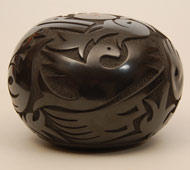
Lucy Year Flower married into the Tafoya family. She married Joe Tafoya who was brother to Joseph Lonewolf and Grace Medicine Flower, the three of whom were the children of Camilio Tafoya and Agapita Silva Tafoya.
Year Flower is an extraordinary artisan and very precise in execution of her work. This seed jar was exquisitely formed and provided a well-balanced surface to support the intricate design chosen. There is an Avanyu over whose head is a radiant sun, a kiva with a tall protrusion that may be a ladder, a dove, flower, and a bear paw. Interspersed between all these elements are other floral-like designs. On the top of the seed jar is a flower executed in red-a symbol used by the artist reflecting her name.
The jar is signed on the underside Lucy Year Flower Pojoaque and Santa Clara Pueblos with the addition of a carved-in small flower above her name.
Condition: appears to be in original condition
Provenance: from a gentleman in Albuquerque
Subject: Black Carved Round Jar with Intricate Carved Design
Artist / Potter: Lucy Year Flower Tafoya (1935-present)
Category: Contemporary
Origin: Santa Clara Pueblo
Medium: clay
Size: 4-5/8" tall x 6-1/2" diameter
Item # C3369D
Subject: Original Painting of Apache Warriors
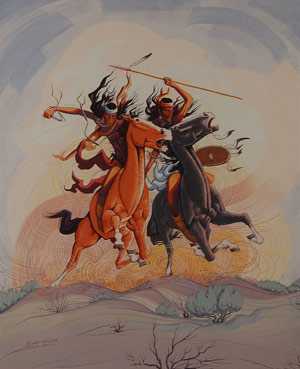 Allan Houser, a Chiricahua Apache, was indisputably one of America's foremost artists in mediums of sculpture, drawing, paintings, wood carving or whatever medium he chose to try. He was a modernist as well as a traditionalist and was certainly one of the most famous Native American artists of the 20th century. By the 1980s, his reputation was firmly established. His paintings were featured in a celebration of Native art at the Kennedy Center in Washington DC in 1981 and included in a Smithsonian exhibit that traveled to South America. That same year, he exhibited in the legendary Salon d'Automne in Paris, France.
Allan Houser, a Chiricahua Apache, was indisputably one of America's foremost artists in mediums of sculpture, drawing, paintings, wood carving or whatever medium he chose to try. He was a modernist as well as a traditionalist and was certainly one of the most famous Native American artists of the 20th century. By the 1980s, his reputation was firmly established. His paintings were featured in a celebration of Native art at the Kennedy Center in Washington DC in 1981 and included in a Smithsonian exhibit that traveled to South America. That same year, he exhibited in the legendary Salon d'Automne in Paris, France.
Houser is most known for his sculptures because that is the medium he worked in in the latter part of his career when he was best known as the artist he was. His paintings are rarer than his sculptures and are highly desired by collectors of Native art.
This painting of two Apache warriors in pursuit of animals or enemy is an extraordinary representation of his truly outstanding talent as a painter. The nostrils of the horses and the fear in their eyes are evidence of the speed the riders are forcing on them and their intent on carrying through with their mission. Houser's interpretative manner in representing the dust being raised by the action of the horses is artistic in itself.
To state that this is an exceptional painting is an understatement. Any accolades one could add to that are well deserved.
Condition: appears to be in original condition, but has not been examine out of the frame.
Provenance: from a Santa Fe couple
Recommended Reading: Allan Houser: An American Master (Chiricahua Apache, 1914-1994) by W. Jackson Rushing III
Subject: Original Painting of Apache Warriors
Artist: Allan Houser (1914-1994)
Category: Paintings
Origin: Chiricahua Apache
Medium: casein
Size: 23-1/2" x 19-1/2" image; 33-1/2" x 29-1/2" framed
Item # C3248
Subject: Bronze Sculpture of Talavai - The Morning Katsina
This bronze of a Talavai (Morning) Katsina is entitled "For a Better Brighter Tomorrow" and is the representation of a Hopi Katsina. In the early morning, as the sun bursts from behind the hills in Hopi lands, morning songs spread their sound: calling birds, barking dogs, and the raised, bell-like voices of early risers greet the new day. The spruce, the first tree touched by the sun's rays, turns from dark shadow into green life with the illumination.
The symbols of the Morning Katsina-his bell that serves to rouse its hearers to a new day, the young spruce tree representing a new beginning, and the headdress feathered out like rays reaching in all directions-all recall the dawning of hope and excitement for a better, brighter tomorrow.
This limited edition bronze by Hopi artist Lowell Talashoma, Sr. is a manifestation of an artistic eye and vision that spans two cultures, for Talashoma is unusual in having spent many of his childhood years in the care of foster parents who raised him in a mainstream American home. Becoming Hopi meant for him accepting a new reality and set of beliefs as well as coming to understand the traditions, ceremonies, languages and social custom implicit in his choice. Giving form to this historically-rich culture is a task he set for himself with pleasure and excitement: what is ancient and inherently true to the Hopi people is newly rediscovered and revered through Talashoma's dawning awareness of what it is to be Hopi.
Lowell Talashoma became a very famous carver of one-piece cottonwood katsina dolls and was selected by American Indian Life and Legends, Ltd as one of two Hopi artists to convert cottonwood katsina dolls into everlasting bronze sculptures. Each of these bronzes was inspired by Hopi beliefs and is "liberated" from cottonwood root-the Hopi traditional carving material-through the vision of the artist of what lies within. Although he could work faster in preparation for bronzing by using wax or clay, Talashoma preferred to interact with the wood, a material he respected for its life and character. The castings made from his carvings via the lost wax method retain that spirit. Even the grain of the original wood can be discerned in the finished bronze.
This bronze of the Morning Katsina was cast in an edition of 35 of which this is number 1. It was completed in 1980. The pedestal on which the bronze stands is on a turntable system to allow for the bronze to be viewed in various positions.
Condition: original condition
Provenance: from the estate of a California family
Recommended Reading: Kachinas: a Hopi Artist's Documentary by Barton Wright
Subject: Bronze Sculpture of Talavai - The Morning Katsina
Artist: Lowell Talashoma, Sr. (1950-2003)
Category: Bronze
Origin: Hopi Pueblo
Medium: bronze casting, wood pedestal
Size: 19-3/4" tall including pedestal
Item # C3365C
Subject: Ohkay Owingeh Child-size Water Jar
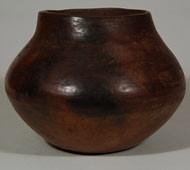 Pottery making at this pueblo almost died out around 1900 except for a few women who made pottery for their own use. There was no market for these rather plain undecorated vessels. It is believed that this small jar dates to around 1900 or a little earlier but it is difficult to date pottery from Ohkay Owingeh because there was little to no change in them over the decades.
Pottery making at this pueblo almost died out around 1900 except for a few women who made pottery for their own use. There was no market for these rather plain undecorated vessels. It is believed that this small jar dates to around 1900 or a little earlier but it is difficult to date pottery from Ohkay Owingeh because there was little to no change in them over the decades.
The arrival of the Spaniards in the late 1500s had very little effect on pottery production at the pueblos in either shape or design, but by the 1700s, there were noticeable changes. Still later, with the opening of the Santa Fe Trail in 1821 and the arrival of the transcontinental railroad in 1880, change became inevitable at pueblos located close to the non-Indian populations.
San Juan Pueblo, now Ohkay Owingeh Pueblo, stuck to its original pottery traditions of simple undecorated utilitarian wares that were so beautiful in vessel shape and simple slipped surfaces highlighted by fire clouds. Even today, a hundred years after the pueblo abandoned its traditional style for a more modern style to appeal to tourists and collectors, the beautiful undecorated wares of the pueblo are still capturing the eyes of collectors.
The red-slipped upper half of the jar is a deeper red color than that seen on jars of a slightly later period. The underbody is the natural, un-slipped, tan clay of the full vessel that was stone polished without the addition of slip. The natural un-slipped interior of the jar was stone polished as well.
It is quite possible this jar was made for sale and not for use at the pueblo as it is generally believed that there was no use for vessels of this size at the pueblo, but that cannot be verified. It certainly could have been made as a teaching aid to a young potter or could have served as a container for small collectibles. The slight off-center of the opening and slight slant to the top rim would lean to attributing it to a beginning potter or one who had not fully matured into an accomplished artisan.
The jar has a wonderfully rich dark red to almost brown upper half with fire clouds on one side.
Condition: structurally in very good condition with some surface slip abrasion
Provenance: from a gentleman in Santa Fe
Recommended Reading: Pueblo Pottery of the New Mexico Indians: Ever Constant, Ever Changing by Betty Toulouse
Subject: Ohkay Owingeh Child-size Water Jar
Potter Unknown
Category: Historic
Origin: Ohkay Owingeh Pueblo (San Juan)
Medium: clay
Size: 5-3/8" tall x 7" diameter
Item # 25613
Subject: San Ildefonso Pueblo Buff-on-red Bowl
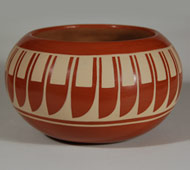 Albert Vigil (1927 - ?) and Josephine Cordova Vigil (1927 - ?) worked together producing pottery their entire married life. Josephine made the pottery and Albert painted them. Albert Vigil was the son of famous San Ildefonso painter Romando Vigil (Tse Ye Mu) and a nephew of Maria Martinez. It was Maria who influenced him to specialize in redware.
Albert Vigil (1927 - ?) and Josephine Cordova Vigil (1927 - ?) worked together producing pottery their entire married life. Josephine made the pottery and Albert painted them. Albert Vigil was the son of famous San Ildefonso painter Romando Vigil (Tse Ye Mu) and a nephew of Maria Martinez. It was Maria who influenced him to specialize in redware.
Josephine Cordova Vigil was originally from Taos Pueblo but moved to San Ildefonso when marrying Albert. Josephine credits Albert's aunts, Maria Martinez and Clara Montoya, with helping them get started in pottery making. She learned by watching Maria make pottery and having Clara show her how to stone polish the pottery.
This beautifully shaped bowl with an incurving rim is decorated with the traditional eagle feather design made popular at San Ildefonso by Julian Martinez. The matte beige color was applied to the red stone-polished slip in a think and luscious coat. The bowl is large and beautiful.
Condition: structurally in original condition with only one very minor abrasion spot.
Recommended Reading: Pueblo Indian Pottery: 750 Artist Biographies by Gregory Schaaf
Subject: San Ildefonso Pueblo Buff-on-red Bowl
Artists / Potters: Albert and Josephine Vigil
Category: Contemporary
Origin: San Ildefonso Pueblo
Medium: clay
Size: 4-7/8" tall x 8-1/2" diameter
Item # C3367B
Subject: Santa Clara Pueblo Buff-on-red Jar
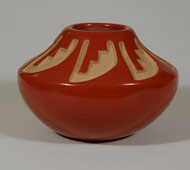 Belen Tapia was Sara Fina Tafoya's niece and Margaret Tafoya's first cousin. She had a long and productive life as a potter and achieved fame for her work. Mostly, she is recognized for her use of several color pigments in designs on her pottery, but she also produced traditional carved pottery of the style familiar to collectors.
Belen Tapia was Sara Fina Tafoya's niece and Margaret Tafoya's first cousin. She had a long and productive life as a potter and achieved fame for her work. Mostly, she is recognized for her use of several color pigments in designs on her pottery, but she also produced traditional carved pottery of the style familiar to collectors.
This deeply carved design is illustrative of her ability to achieve clean-cut designs in straight line or curved forms. The burnishing of the red slip is flawless. Tapia was an accomplished potter and that is evident in this jar.
Condition: The buff color matte clay of the design element has some grey spotting that is not dust and does not rub off, so I do not know what it might be.
Recommended Reading: Pueblo Indian Pottery: 750 Artist Biographies by Gregory Schaaf
Subject: Santa Clara Pueblo Buff-on-red Jar
Artist / Potter: Belen Tapia (1914-1999)
Category: Contemporary
Origin: Santa Clara Pueblo
Medium: clay
Size: 5-1/4" x 7-3/4" diameter
Item # C3367A
Subject: Acoma Pueblo White Corrugated Pottery Owl
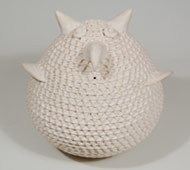 This is a very traditional white corrugated owl figurine that was built up from coils of clay left in roll form, not smoothed out. The rows were then impressed with a stick or other tool to achieve the design. This is similar to prehistoric utilitarian wares in which the rows of coils of clay were left visible.
This is a very traditional white corrugated owl figurine that was built up from coils of clay left in roll form, not smoothed out. The rows were then impressed with a stick or other tool to achieve the design. This is similar to prehistoric utilitarian wares in which the rows of coils of clay were left visible.
Stella Shutiva spent most of her career making pottery in the fashion of pre-historic corrugated utilitarian wares, a style revived by her mother, Jessie Garcia. She said she admired her mother's corrugated pottery so much that she vowed she would learn how to make it herself. It took her four years to master the technique, but master it she did.
Jessie Garcia, Shutiva's mother, is given credit for reviving the ancient art of corrugated pottery, but instead of the earth-colored clay generally used for the prehistoric corrugated wares; she chose to use the white, un-slipped Acoma clay, thus marrying the style of the old ways with a look of the new.
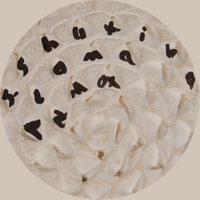 Shutiva brought her mother's creation to fruition and spent her career almost exclusively devoted to making white corrugated wares. Adding painted designs to small portions of her pottery was an addition late in her career as was the addition of animal and reptile forms in bas-relief.
Shutiva brought her mother's creation to fruition and spent her career almost exclusively devoted to making white corrugated wares. Adding painted designs to small portions of her pottery was an addition late in her career as was the addition of animal and reptile forms in bas-relief.
This owl figurine was probably made in the 1980s. The corrugated rows of clay are continuous from the bottom of the vessel to the top. There is no flattened bottom to the vessel. The artisan's name is painted on the underside.
Condition: appears to be in original condition but perhaps with a little more dust.
Recommended Reading: Southern Pueblo Pottery 2,000 Artist Biographies by Gregory Schaaf
Subject: Acoma Pueblo White Corrugated Pottery Owl
Artist / Potter: Stella Shutiva (1939-1997)
Category: Contemporary
Origin: Acoma Pueblo
Medium: clay
Size: 8-3/4" tall x 9-5/8" diameter
Item # C3367D
Subject: Acoma Pueblo Black-on-white Seed Jar by Rose Chino
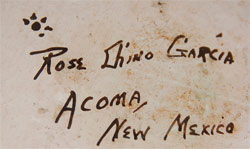 Rose Chino and her sisters, Carrie Chino Charlie, Vera Chino Ely and Grace Chino, are daughters of Marie Z. Chino and all of them are exceptional potters, as was their mother. Garcia's pottery is in the collections of the Peabody Museum at Harvard University, Heard Museum in Phoenix, Philbrook Museum of Art in Tulsa, and numerous private collections. She has won awards at Santa Fe Indian Market since 1975-one award was for "most creative design."
Rose Chino and her sisters, Carrie Chino Charlie, Vera Chino Ely and Grace Chino, are daughters of Marie Z. Chino and all of them are exceptional potters, as was their mother. Garcia's pottery is in the collections of the Peabody Museum at Harvard University, Heard Museum in Phoenix, Philbrook Museum of Art in Tulsa, and numerous private collections. She has won awards at Santa Fe Indian Market since 1975-one award was for "most creative design."
Rose Chino Garcia learned pottery making from her famous mother and has used some of her mother's designs, however, she has also been very creative in developing designs of her own, designs that have proven most successful as recognized by the Santa Fe Indian Market award mentioned above.
One must look at the design on this seed jar very carefully to notice the geometrics involved. First, straight lines of longitude traverse from the opening at the top of the jar to the base. Second, another series of lines swirl and cross over the longitudinal lines, then the triangles formed by the intersection of the lines are painted black. After viewing the design in that manner, take another look at a group of black diamonds surrounding a white block and one can see a star pattern. This is a good reason to encourage students of pottery to study geometry.
The jar appears to date from the last quarter of the 20th century-probably the 1980s. It is signed Rose Chino Garcia Acoma, New Mexico and has an animal paw hallmark.
Condition: structurally in excellent condition. It has about three small spall marks
Recommended Reading: Southern Pueblo Pottery 2,000 Artist Biographies by Gregory Schaaf
Subject: Acoma Pueblo Black-on-white Seed Jar by Rose Chino
Artist / Potter: Rose Chino Garcia (1928-present)
Category: Contemporary
Origin: Acoma Pueblo
Medium: clay, pigment
Size: 3-7/8" tall x 8-1/4" diameter
Item # C3367E
Subject: Large Hopi Tasap Katsina Doll
This is an exceptional Hopi Tasap Katsina doll carved from a piece of cottonwood root. Tasap is a Hopi representation of a Navajo God. There are Hopi versions of katsinam that honor and depict other tribes, such as the Navajo, Havasupai, Comanche, Zuni and other Pueblos.
This is the Hopi version of what the Navajo katsinam might look like. These katsinam are not borrowed from the Navajo, as they are unique to the Hopi. They have the same purpose and functions as all the Hopi Katsinam. They are messengers and/or intermediaries to the rain gods. Since they are katsinam in every respect, they are afforded the same reverence and dignity during their visits.
This Tasap male katsinam wears a ceremonial kilt and rain sash, and has a blue face and red hair. The male, along with a companion female, appears during Angak'wa and the summer katsina day dances. Since they depict the Navajo, their songs may have some Navajo words speaking of the good things of life and/or words representing moisture.
Condition: The carving is in excellent condition.
Subject: Large Hopi Tasap Katsina Doll
Carver Unknown
Category: Traditional
Origin: Hopi Pueblo
Medium: Cottonwood root, Feather, Paint
Size: 13" tall
Item # C3145.01
Subject: Historic Nineteenth Century Polychrome Bowl, circa 1870s
One can almost feel the peacefulness at sunset as the sky turns from a fiery red to yellow. Rarely do we see Zuni bowls with a red underbody. Since the late-1800s, most potters have used black. According to Batkin, "Zuni Polychrome vessels retained the red rim and underbody slip of Ashiwi Polychrome until the late eighteenth or early nineteenth century, when it was replaced by dark brown paint..." ¹
The paste materials are typically Zuni; white and chunky in texture with the centuries old temper material of ground pottery shards. The use of old shards for temper evidences the regard of the pueblo peoples for the old works made by their predecessors. To add these remnants to the new work is a sign of respect.
The rim of the bowl curves inward slightly, imparting a graceful shape to what could otherwise be an uninteresting one. The interior of the rim flexes slightly, an unnecessary added feature that enhances its shape. The bowl is slipped in traditional fashion with cream-colored clay, over which is painted the designs in mineral and vegetal paints. The exterior is decorated with the traditional prayer stick design used on every Zuni bowl made in the nineteenth century. It is thought that this was a woman's way to place her prayers since women do not make prayer sticks.
The interior decoration begins with a brown rim, below which is a series of rectangles divided into triangles encircling the bowl that are rendered solely in brown. Below this are two wide parallel framing lines with a very distinctive ceremonial break. Two Zuni volute design elements in brown paint fill the interior of the bowl. These are attached to two corn-like elements, executed in red without outlining. The bottom has a double circle, one of which is cloud-like, outlining an otherwise undecorated center. On the exterior of the bowl is written the numbers 39975 in beautiful hand Script. This is most certainly an acquisition number placed there by one of the earlier expeditions to Zuni.
UPDATE INFORMATION: Dwight Lanmon so kindly provided the following information. The numbers 39975 are BAE accession numbers indicating that Stevenson collected the bowl in 1879 on the Powell Expedition. He confirmed with the Smithsonian that the numbers 475 are Stevenson's field numbers.
Subject: Historic Nineteenth Century Polychrome Bowl, circa 1870s
Potter Unknown
Category: Historic
Origin: Zuni Pueblo
Medium: native clay and pigments
Size: 7-3/4" diameter x 3-1/2" deep
Item # C3361B
Subject: Pair of Hopi Polychrome Cylindrical Jars
Pauline Setalla married into the Frog Woman/Feather Woman family clan. It was reported by her son several years ago that she was in ill health and retired from making pottery. We have not had an update on her health since that time. She had 10 children, some of whom are potters carrying on her legacy. She was raised on the Second Mesa village of Mishongnovi on the Hopi Reservation. She learned pottery production techniques from her mother-in-law, Agnes Setalla Nahsonhoya, and her sister-in-law, Eunice Navasie.
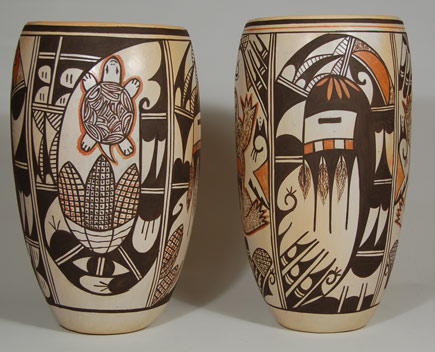 All of Setalla's pottery was formed in the traditional coil technique from native clay and slipped with vegetal paints and painted in the traditional manner. Firing was with sheep dung, a popular way at Hopi. This pair of Hopi cylinders was made in that manner.
All of Setalla's pottery was formed in the traditional coil technique from native clay and slipped with vegetal paints and painted in the traditional manner. Firing was with sheep dung, a popular way at Hopi. This pair of Hopi cylinders was made in that manner.
We are presenting this pair of cylinders together; however, they may be purchased separately. Both feature the face of a Long Hair Katsina in opposing panels of decoration and one of the cylinders features a bowl of corn and a turtle image and the other cylinder features a large frog image on opposing panels. They make a wonderful pair should someone want both. They are the same size and style and are complimentary to each other. Another item, also by Pauline Setalla, is a large storage jar with similar decoration as these two cylinders. It is our item number C3309K.
Condition: structurally in original condition with some minor over-paint on brown color.
Provenance: from the collection of Katherine H. Rust whose collection was mostly amassed in the 1960s and 1970s so it is assumed that is the approximate period that these were made.
Recommended Reading: Hopi-Tewa Pottery: 500 Artist Biographies by Gregory and Angie Schaaf
Subject: Pair of Hopi Polychrome Cylindrical Jars
Artist / Potter: Pauline Setalla (1930-?)
Category: Contemporary
Origin: Hopi Pueblo
Medium: clay, pigment - Price is for EACH
Size: 11-3/4" tall x 7-1/4" diameter - Price is for EACH
Item # C3309H-J
Subject: Navajo (Diné) Painting of a Young Navajo Boy with Frog
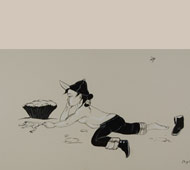 Probably no other Navajo artist has chronicled activities of Navajo children as well or as often as Beatien Yazz. In a large percentage of his paintings he featured Navajo youth playing, working, or just relaxing. He presented life on the Navajo Reservation as ideal for its youth.
Probably no other Navajo artist has chronicled activities of Navajo children as well or as often as Beatien Yazz. In a large percentage of his paintings he featured Navajo youth playing, working, or just relaxing. He presented life on the Navajo Reservation as ideal for its youth.
In this painting, Yazz shows a young Navajo boy, shirtless, lying on the ground teasing a frog by holding on to its leg. There is a charm to the painting. The young boy is resting his head on his hand, kicked off his moccasin and is only interested in the frog.
Provenance: This painting is from an Albuquerque collector, and is not from the collection of the Balcomb family. It is framed and in original excellent condition.
Subject: Navajo (Diné) Painting of a Young Navajo Boy with Frog
Artist: Beatien Yazz (1928-Present) Little No Shirt - Jimmy Toddy
Category: Paintings
Origin: Diné - Navajo Nation
Medium: Casein
Size: 12-1/2" x 18" image; 17-3/4" x 23-1/8" framed
Item # C2981
Subject: Bronze Sculpture of Tasap-Navajo Yei-bi-chai Katsina
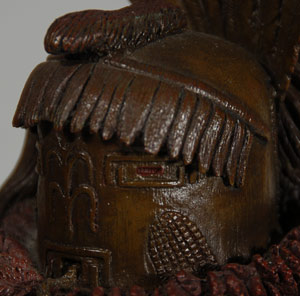 This bronze of a Tasap-Navajo Yei-bi-chai Katsina is entitled "Spiritual Peace" and is the representation of a Hopi Katsina in honor of the Navajo people. It is a silent figure and steps forward to lead others in ritual dance steps.
This bronze of a Tasap-Navajo Yei-bi-chai Katsina is entitled "Spiritual Peace" and is the representation of a Hopi Katsina in honor of the Navajo people. It is a silent figure and steps forward to lead others in ritual dance steps.
This katsina stands for the complex and often embittered relationship existing between the Navajo and Hopi tribes who share traditional lands in northern Arizona. His Navajo mannerisms and appearance are sometimes comical to the Hopi people. Still, with a longing recognizable as universal, he expresses the desire for peace, order and spiritual unity that comes from settling disputes between discordant neighbors.
The Tasap Yei-bi-chai Katsina is the Grandfather of the Navajo Katsina and appears during the Navajo Katsina Dance. He does not speak but pantomimes whatever he wants. He starts the dance, acting as a leader in both singing and dancing. His dance step is an exaggeration, and a very lively one, that may be interspersed with a comic action such as a request for food-mountains of food. All of these requests are done in pantomimes that bring laughter to the audience.
This bronze was sponsored by American Indian Life and Legends of Arizona who produced a number of bronzes of Katsinas by Lowell Talashoma, Sr. and Neil David, Sr. The company is now out of business and all the bronzes are available only through resale.
This bronze and others by Talashoma are the manifestations of an artistic eye and vision that spans two cultures, for Talashoma is unusual in having spent many of his childhood years in the care of foster parents who raised him in a mainstream American home. Becoming Hopi meant for him accepting a new reality and set of beliefs as well as coming to understand the traditions, ceremonies, languages and social customs implicit in his choice. Giving form to this historically-rich culture is a task Talashoma set for himself with pleasure and excitement; what is ancient and inherently true to the Hopi people is newly rediscovered and revered through his dawning awareness of what it is to be Hopi.
Each form and figure tells a story as does the process Talashoma employed in its creation. His images were inspired by Hopi beliefs and are "liberated" from cottonwood root-the Hopi traditional carving material-through Talashoma's vision of what lies within. Although he could have worked faster in preparation for bronzing by using wax or clay, he preferred to interact with the wood, a material he respected for its life and character. The castings made from his carvings via the lost wax method retain that spirit. Even the grain of the original wood can be discerned in the finished bronze.
This bronze was cast in an edition of 35 of which this is number 1. It was completed in 1982. This Katsina doll was awarded 1st Place, Best of Class and Best of Show at the 1982 New Mexico State Fair. It received 1st Place and two special awards from the Heard Museum Guild and also 1st Place and Best of Class from Sandra Day O'Connor O'odahm Tash. The wood pedestal that supports the bronze is on a rotating base so that the bronze may be rotated and viewed from various positions.
Condition: original condition
Provenance: from the estate of a California family
Recommended Reading: Kachinas: a Hopi Artist's Documentary by Barton Wright
Subject: Bronze Sculpture of Tasap-Navajo Yei-bi-chai Katsina
Artist: Lowell Talashoma, Sr. (1950-2003)
Category: Bronze
Origin: Hopi Pueblo
Medium: bronze casting, wood pedestal
Size: 13-3/4" bronze height; 15-3/4" on pedestal
Item # C3365B
Biography: Lowell Talashoma, Sr. (1950-2003)
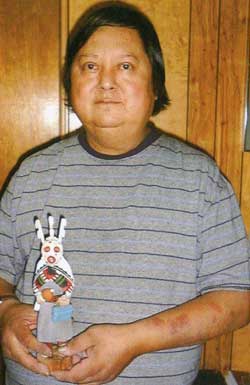 Lowell Talashoma, Sr.'s life story already seems to possess some of those rare qualities that distinguish those of legendary proportions from the ordinary. At less than two years of age he was moved from his family home on the Hopi mesas in Northern Arizona. Due to hard times, Lowell's parents gave their permission for this son to go to Utah and live with an elderly Mormon couple. Reared by this couple as an "only" son, Lowell discovered mainstream America and a Christian household.
Lowell Talashoma, Sr.'s life story already seems to possess some of those rare qualities that distinguish those of legendary proportions from the ordinary. At less than two years of age he was moved from his family home on the Hopi mesas in Northern Arizona. Due to hard times, Lowell's parents gave their permission for this son to go to Utah and live with an elderly Mormon couple. Reared by this couple as an "only" son, Lowell discovered mainstream America and a Christian household.
A natural artist, Lowell produced drawings and sculptures with perspective, proportion and grace at an age when other children marked out crude symbols. While still in grade school he whittled a freely-turning sphere within a cage from a single block of wood. He would, while still a child, illustrate a story as it was being read aloud.
Stimulated by visits back to his Hopi family, Lowell began to long for the culture he was missing. With ideas and visions he took back to his adoptive home, Lowell through his own artistic ability began to discover the need for his native heritage. One day while visiting on the mesa, the time came for Lowell to return to Utah. He surprised everyone including himself by refusing to leave his Hopi homeland. He stayed to become himself, a Hopi.
There are few cultures in the world today that have such a strong sense of purpose and place as the Hopi culture. Lowell learned when he reclaimed his heritage that to be a Hopi meant becoming aware of the spirit of all things. He began acknowledging the reality of village customs and ceremony that were very different from Little League and the Christmas holidays he knew as a child in Utah. Lowell found that the very foundation of Hopi life rests on the principles of Kachinas and direction from the Creator.
Lowell has garnered numerous prestigious awards in various fine art competitions and exhibits. Top honors were accumulated from the likes of the Museum of Northern Arizona, the Gallup Inter-Tribal Ceremonial and the Santa Fe Indian Market. A memorable exhibit at the Heard Museum Guild-Native American Arts Exhibit earned Lowell the Sandra Day O'Connor Special Award for Kachinas.
Highly regarded for the movement and excitement captured in his cottonwood root sculptures, Lowell's devotion and dedication to his Hopi heritage was reflected. This mastering of his talent provided Lowell and his wife Karen, three daughters and two sons, additional inspiration in the Hopi way. Lowell's total commitment to art, accuracy and his exquisitely beautiful message of movement is felt when one views a creation from this master artist.
Lowell also worked in bronze, and many of those creations are shown in major galleries around the country. The original for each bronze was carved from wood, taking months to complete. Lowell used a process called the lost wax method to make each bronze casting. The bronze is so perfect that one can actually see the wood grain from the original carving reproduced in the bronze. Talashoma's works are in select corporate and private collections, including those of the Valley National Bank of Arizona, Otero Savings and Loan of Colorado, renowned photographer Jerry Jacka and actor, producer, author and Southwestern enthusiast Robert Redford.
Photo Credit: from the book Hopi Katsina: 1,600 Artist Biographies by Gregory and Angie Schaaf
Subject: Kewa (Santo Domingo) Depression-era Thunderbird Necklace
During the 1930s when the Depression-era was in full swing, New Mexico Pueblo Indians were severely affected. At Santo Domingo Pueblo (now Kewa Pueblo), the Indians became very resourceful and began producing jewelry from whatever materials they could find. One particular folk art creation they produced has become a very collectible item: the Depression-era necklace. Production continued at a lesser rate into the mid-20th century.
This necklace was made from several "found materials." The beads were made from bone, the black backing probably from automotive battery casing, the red from toothbrush handles or something similar, and the turquoise is genuine. These necklaces were usually in the squash blossom style, with pendants protruding from the sides and a bird pendant at the bottom, as is this one.
The dark green turquoise superimposed over the black casing material displays a rich and wonderful patina against the opaque bone beads that also have assumed a warm and old patina. The Thunderbird pendant is resplendent in all its red and white, particularly the star on the bird's body. This is a very good example of this style necklace.
Condition: very good condition.
Provenance: from a resident of Colorado
Recommended Reading: "Santo Domingo Pueblo Jewelry" by Sally and J. Roderick Moore in The Magazine Antiques, Brant Publications, Inc. July 2009, vol. CLXXVI, no. 1. pp. 56-61.
Subject: Kewa (Santo Domingo) Depression-era Thunderbird Necklace
Jeweler Unknown
Category: Necklaces
Origin: Kewa Pueblo (Santo Domingo)
Medium: bone, turquoise, plastic
Size: 26" long; 2-3/8" x 1-3/4" thunderbird
Item # C3366
Subject: Zuni Pueblo Knifewing Pin with Multiple Stones
This channel-inlay pin consists of turquoise, jet, mother-of-pearl, and Spondylus shell, mounted in silver bezels on silver backing. Silver wire earrings and a "halo" around the wing and tail feathers complete the ensemble. The pin probably dates to the second half of the 20th century. The pin clasp has a safety hook. It is not signed with the name of the maker.
Condition: as new
Provenance: from a gentleman in Santa Fe
Recommended Reading: Zuni Jewelry by Theda and Michael Bassman
Subject: Zuni Pueblo Knifewing Pin with Multiple Stones
Jeweler Unknown
Category: Pins
Origin: Zuni Pueblo
Medium: multi stones
Size: 1-3/8" x 1-5/8"
Item # C3190G
Subject: San Ildefonso Buff-on-red Jar signed Marie
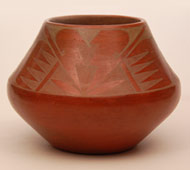 The pottery of Maria and Julian Martinez is much more diverse than the casual observer recognizes. After their marriage in 1904, Maria was making pottery and Julian began decorating it for her. Their first pottery was the traditional San Ildefonso Polychrome style and this continued for another decade before they began making blackware. Maria was an excellent potter and Julian an excellent painter. He painted the designs with mineral paints using a paint brush fashioned from the leaf of a yucca plant. Julian had a natural artistic sense and quickly became proficient.
The pottery of Maria and Julian Martinez is much more diverse than the casual observer recognizes. After their marriage in 1904, Maria was making pottery and Julian began decorating it for her. Their first pottery was the traditional San Ildefonso Polychrome style and this continued for another decade before they began making blackware. Maria was an excellent potter and Julian an excellent painter. He painted the designs with mineral paints using a paint brush fashioned from the leaf of a yucca plant. Julian had a natural artistic sense and quickly became proficient.
Around 1912, Maria and Julian began producing plain polished Blackware pottery based on the tradition of the Tewa-speaking pueblos—Santa Clara, San Juan, San Ildefonso and Nambe. By 1919-20, Maria and Julian made a true discovery with the development of Black-on-black ware. Previously the Tewa black pottery was without decoration. It was Maria and Julian who devised the manner of adding a design.
Originally, Maria did not sign her pottery as it was and is the tradition of Pueblo Indians not to stand out from others of the village. Everyone is equal and everyone participates in events. Eventually she was convinced that it was important for collectors to have signed pottery, so, in 1923, she began signing the name Marie. The name Marie was selected because it was believed that the general public would understand Marie rather than Maria. Additionally, Marie was not her name as everyone in the village knew her by her Tewa name Poveka. Perhaps this was her way of satisfying the collectors without breaking pueblo tradition. Around 1925, Maria started adding Julian's name to the wares.
During the early years of their collaborative efforts, Maria and Julian produced Polychrome, Black-on-red, Buff-on-red, and Black-on-black pottery. Of these, the redware is the rarest of all pottery they produced. Black ware was so popular with collectors in the early years that they rarely fired any red ware. This piece, signed Marie, would have been made between 1923 and 1925, the only period that their pottery was signed in that manner. The design is also an earlier style of Julian's work. The checkerboard elements running vertical on the shoulder rarely appear after the 1930s.
This is a rare opportunity for a collector to add a piece of very hard-to-find Maria and Julian pottery to his or her collection.
Condition: The vessel is in very good condition; however the red slip shows some scarring due to moisture. There is no other damage, however.
Provenance: originally from a Minnesota collector
Recently from the estate of Michael F. Frost
Recommended Reading: The Legacy of Maria Poveka Martinez by Richard Spivey
Subject: San Ildefonso Buff-on-red Jar signed Marie
Artist / Potter: Maria Martinez 1887-1980
Category: Contemporary
Origin: San Ildefonso Pueblo
Medium: clay, pigment
Size: 5-3/4" tall x 7-3/4" diameter
Item # C3360H


